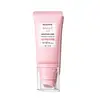What's inside
What's inside
 Key Ingredients
Key Ingredients

 Benefits
Benefits

 Concerns
Concerns

 Ingredients Side-by-side
Ingredients Side-by-side

Water
Skin ConditioningButylene Glycol
HumectantHomosalate
Skin ConditioningIsoamyl P-Methoxycinnamate
UV AbsorberMethylene Bis-Benzotriazolyl Tetramethylbutylphenol
UV FilterSilica
AbrasiveBis-Ethylhexyloxyphenol Methoxyphenyl Triazine
Skin ConditioningDiethylhexyl Butamido Triazone
UV AbsorberDibutyl Adipate
EmollientCaprylyl Methicone
Skin ConditioningNiacinamide
SmoothingButyloctyl Salicylate
Skin ConditioningDiethylamino Hydroxybenzoyl Hexyl Benzoate
UV FilterEthylhexyl Triazone
UV AbsorberCI 77891
Cosmetic ColorantAlpha-Arbutin
AntioxidantTranexamic Acid
AstringentTocopherol
AntioxidantDecyl Glucoside
CleansingPhenoxyethanol
PreservativeAcrylates/C10-30 Alkyl Acrylate Crosspolymer
Emulsion StabilisingPotassium Cetyl Phosphate
EmulsifyingTromethamine
BufferingChlorphenesin
AntimicrobialPEG-240/Hdi Copolymer Bis-Decyltetradeceth-20 Ether
StabilisingDisodium EDTA
Ethylhexylglycerin
Skin ConditioningPropylene Glycol
HumectantPhytic Acid
Xanthan Gum
EmulsifyingSodium Hydroxide
BufferingPotassium Laurate
EmulsifyingWater, Butylene Glycol, Homosalate, Isoamyl P-Methoxycinnamate, Methylene Bis-Benzotriazolyl Tetramethylbutylphenol, Silica, Bis-Ethylhexyloxyphenol Methoxyphenyl Triazine, Diethylhexyl Butamido Triazone, Dibutyl Adipate, Caprylyl Methicone, Niacinamide, Butyloctyl Salicylate, Diethylamino Hydroxybenzoyl Hexyl Benzoate, Ethylhexyl Triazone, CI 77891, Alpha-Arbutin, Tranexamic Acid, Tocopherol, Decyl Glucoside, Phenoxyethanol, Acrylates/C10-30 Alkyl Acrylate Crosspolymer, Potassium Cetyl Phosphate, Tromethamine, Chlorphenesin, PEG-240/Hdi Copolymer Bis-Decyltetradeceth-20 Ether, Disodium EDTA, Ethylhexylglycerin, Propylene Glycol, Phytic Acid, Xanthan Gum, Sodium Hydroxide, Potassium Laurate
Water
Skin ConditioningCyclohexasiloxane
EmollientEthylhexyl Methoxycinnamate
UV AbsorberSilica
AbrasiveEthylhexyl Salicylate
UV AbsorberGlycerin
HumectantTitanium Dioxide
Cosmetic ColorantPEG-10 Dimethicone
Skin ConditioningCaprylyl Methicone
Skin ConditioningZinc Oxide
Cosmetic ColorantPolymethyl Methacrylate
Pentylene Glycol
Skin ConditioningGlyceryl Glucoside
HumectantPachyrhizus Erosus Root Extract
Skin Conditioning1,2-Hexanediol
Skin ConditioningCetyl PEG/PPG-10/1 Dimethicone
EmulsifyingMagnesium Sulfate
CI 77007
Cosmetic ColorantAllantoin
Skin ConditioningTrimethylsiloxysilicate
EmollientAluminum Hydroxide
EmollientStearic Acid
CleansingHydroxyacetophenone
AntioxidantOctyldodecanol
EmollientDisteardimonium Hectorite
StabilisingButylene Glycol
HumectantGlyceryl Caprylate
EmollientDipotassium Glycyrrhizate
HumectantDimethicone
EmollientHelianthus Annuus Seed Oil
EmollientPropanediol
SolventSodium Phytate
Triethoxycaprylylsilane
Methyl Diisopropyl Propionamide
MaskingPolyhydroxystearic Acid
EmulsifyingBHT
AntioxidantNeopentyl Glycol Diethylhexanoate
EmollientTremella Fuciformis Extract
HumectantLavandula Angustifolia Flower/Leaf/Stem Extract
MaskingEthyl Ferulate
AntioxidantAscorbyl Glucoside
AntioxidantRosmarinus Officinalis Leaf Extract
AntimicrobialTocopherol
AntioxidantEthylhexylglycerin
Skin ConditioningMagnesium Chloride
Panthenol
Skin ConditioningCalcium Gluconate
HumectantPyridoxine Hcl
Skin ConditioningYeast Extract
Skin ConditioningCyanocobalamin
Skin Conditioning3-O-Ethyl Ascorbic Acid
Skin ConditioningTerminalia Ferdinandiana Fruit Extract
AntioxidantWater, Cyclohexasiloxane, Ethylhexyl Methoxycinnamate, Silica, Ethylhexyl Salicylate, Glycerin, Titanium Dioxide, PEG-10 Dimethicone, Caprylyl Methicone, Zinc Oxide, Polymethyl Methacrylate, Pentylene Glycol, Glyceryl Glucoside, Pachyrhizus Erosus Root Extract, 1,2-Hexanediol, Cetyl PEG/PPG-10/1 Dimethicone, Magnesium Sulfate, CI 77007, Allantoin, Trimethylsiloxysilicate, Aluminum Hydroxide, Stearic Acid, Hydroxyacetophenone, Octyldodecanol, Disteardimonium Hectorite, Butylene Glycol, Glyceryl Caprylate, Dipotassium Glycyrrhizate, Dimethicone, Helianthus Annuus Seed Oil, Propanediol, Sodium Phytate, Triethoxycaprylylsilane, Methyl Diisopropyl Propionamide, Polyhydroxystearic Acid, BHT, Neopentyl Glycol Diethylhexanoate, Tremella Fuciformis Extract, Lavandula Angustifolia Flower/Leaf/Stem Extract, Ethyl Ferulate, Ascorbyl Glucoside, Rosmarinus Officinalis Leaf Extract, Tocopherol, Ethylhexylglycerin, Magnesium Chloride, Panthenol, Calcium Gluconate, Pyridoxine Hcl, Yeast Extract, Cyanocobalamin, 3-O-Ethyl Ascorbic Acid, Terminalia Ferdinandiana Fruit Extract
 Reviews
Reviews

Ingredients Explained
These ingredients are found in both products.
Ingredients higher up in an ingredient list are typically present in a larger amount.
Butylene Glycol (or BG) is used within cosmetic products for a few different reasons:
Overall, Butylene Glycol is a safe and well-rounded ingredient that works well with other ingredients.
Though this ingredient works well with most skin types, some people with sensitive skin may experience a reaction such as allergic rashes, closed comedones, or itchiness.
Learn more about Butylene GlycolCaprylyl Methicone is a type of silicone.
It helps soften and soothe the skin by creating a thin film on top. This film helps trap moisture, keeping your skin hydrated.
Ethylhexylglycerin (we can't pronounce this either) is commonly used as a preservative and skin softener. It is derived from glyceryl.
You might see Ethylhexylglycerin often paired with other preservatives such as phenoxyethanol. Ethylhexylglycerin has been found to increase the effectiveness of these other preservatives.
Silica, also known as silicon dioxide, is a naturally occurring mineral. It is used as a fine, spherical, and porous powder in cosmetics.
Though it has exfoliant properties, the function of silica varies depending on the product.
The unique structure of silica enhances the spreadability and adds smoothness, making it a great texture enhancer.
It is also used as an active carrier, emulsifier, and mattifier due to its ability to absorb excess oil.
In some products, tiny microneedles called spicules are made from silica or hydrolyzed sponge. When you rub them in, they lightly polish away dead skin layers and enhance the penetration of active ingredients.
Learn more about SilicaTocopherol (also known as Vitamin E) is a common antioxidant used to help protect the skin from free-radicals and strengthen the skin barrier. It's also fat soluble - this means our skin is great at absorbing it.
Vitamin E also helps keep your natural skin lipids healthy. Your lipid skin barrier naturally consists of lipids, ceramides, and fatty acids. Vitamin E offers extra protection for your skin’s lipid barrier, keeping your skin healthy and nourished.
Another benefit is a bit of UV protection. Vitamin E helps reduce the damage caused by UVB rays. (It should not replace your sunscreen). Combining it with Vitamin C can decrease sunburned cells and hyperpigmentation after UV exposure.
You might have noticed Vitamin E + C often paired together. This is because it is great at stabilizing Vitamin C. Using the two together helps increase the effectiveness of both ingredients.
There are often claims that Vitamin E can reduce/prevent scarring, but these claims haven't been confirmed by scientific research.
Learn more about TocopherolWater. It's the most common cosmetic ingredient of all. You'll usually see it at the top of ingredient lists, meaning that it makes up the largest part of the product.
So why is it so popular? Water most often acts as a solvent - this means that it helps dissolve other ingredients into the formulation.
You'll also recognize water as that liquid we all need to stay alive. If you see this, drink a glass of water. Stay hydrated!
Learn more about Water